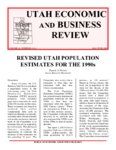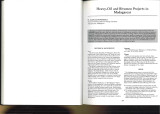TO
1 - 25 of 24
| Title | Date | Subject | Description | ||
|---|---|---|---|---|---|
| 1 |
 | Taking another look at Utah's tar sand resources | 2009 | tar sand; tar sand resources; unconventional energy resource; alternate energy resource; oil impregnated sandstone; oil sand; bitumous sandstone; energy resource | Recent increases in the price of crude oil have sparked renewed interest in unconventional energy resources, including Utah s tar sands. Tar sands (also called oil-impregnated sandstones, oil sands, and bituminous sandstones) are, as the names imply, sandstones that are saturated or filled with blac... |
| 2 |
 | Geology of the Mill Fork Area, Utah | 1972-12 | geology; Mill Fork area; geologic structure; Green River formation | The Mill Fork area comprises about 70 square miles of Cretaceous ( ? ) and Tertiary sediments at the northern end of the Wasatch Plateau in Utah County, Utah. Over 9000 feet of nonmarine sediments are present and belong to the North Horn, Flagstaff, and Green River formations. These sediments record... |
| 3 |
 | Revised Utah population estimates for the 1990s | 2001-05 | Every 10 years, the U.S. Bureau of the Census conducts a population count. In the intervening years the Utah Population Es timates Committee (UPEC) annually prepares total resident population estimates for each of the 29 counties in the state. These estimates are based on methods that ut i l i z e s... | |
| 4 |
 | Field guide to lacustrine and related nonmarine depositional environments in tertiary rocks, Uinta Basin, Utah | 1976-11 | lacustrine environments; nonmarine depositional environments; tertiary rocks | The lower part of the Tertiary System in the Uinta Basin of northeastern Utah and northwestern Colorado (fig. 1) reflects a series of very complex and variable forms of continental sedimentation in a basin of internal drainage. These complex forms represent the disruption of the Cretaceous depositio... |
| 5 |
 | Biofuels--snake oil for the twenty-first century | 2008-12-01 | Most Americans are painfully aware that our present consumption of petroleum is unsustainable. The United States has less than 5% of the world's population, but consumes 24.4% of the world's petroleum production. Only 8.5% of the world's petroleum production comes from American wells, which necessit... | |
| 6 |
 | Light-oils transformation to heavy oils and asphalts-assessment of the amounts of hydrocarbons removed and the hydrological-geological control of the process | 1987 | light-oils; heavy oils; asphalts; assessment; hydrocarbons; petroleum resources; oil alteration | Heavy oils frequently represent a residue left after removal of saturated and aromatic hydrocarbons by various alteration processes. They are characterized by a high content of asphaltenes and polar compounds and by higher sulfur content than the light oils from which they were derived. In the Dead ... |
| 7 |
 | Major tar sand and heavy oil deposits of the United States | 1985-07 | major tar sand; heavy oil deposits; heavy oil resources; tar sand resources; United States | This paper presents a current assessment of U.S. tar sand and heavy oil resources. It is based on an independent appraisal of all tar sand deposits with 100 million barrels in place or more and the construction of a heavy oil reservoir and data base of fields containing more than 20 million barrels ... |
| 8 |
 | Tar sand extraction method due tests | 1986-04-28 | tar sand extraction method; due tests; bitumen recovery; Athabasca sands; Solv-Ex process | Shell Canada aims to recover as much as 96% of bitumen from Athabasca sands with Solv-Ex process in pilot tests at Albuquerque. Results could lead to 1987 decision to proceed with a 7,500 bled mining/extraction project at Alberta site. |
| 9 |
 | Heavy-oil and bitumen projects in Madagascar | 1987 | heavy oil; bitumen; Madagascar; Bemolanga tar sand; Tsimiroro heavy crude oil; mining and bitumen-separation operation | Madagascar contains two important deposits, the Bemolanga tar sand and the Tsimiroro heavy crude oil. Although known for years, they have received intensive investigation recently in effort to achieve a measure of energy independence in the face of rising oil costs and dollar-exchange values. The ai... |
| 10 |
 | Tar sand research and development at the University of Utah | 1987 | tar sand research; tar sand development; hydrocarbon recovery; extensive tar sand deposits; in situ thermal production; bitumen; surface mining; hydrocarbon liquid | The recovery of hydrocarbon values from the extensive tar sand deposits of North America has generally been approached by one of two methods: in situ thermal production of the bitumen or of a bitumen-derived liquid or surface mining of the deposit followed by processing of the mined ore. In either a... |
| 11 |
 | Getting from here to there: Devising an optimal regulatory model for CO2 transport in a new carbon capture and sequestration industry | 2010 | regulatory model for CO2 transport; new carbon capture and sequestration; CCS; regulatory model | If CCS is to become a broad-scale commercial industry in time to meet the need for climate change mitigation, the United States must adopt a regulatory model that will allow for efficient construction of critical infrastructure. A well-crafted regulatory framework gives private would-be CCS operator... |
| 12 |
 | State and regional control of geological carbon sequestration (Part I) | 2011-05 | state and regional control; geological carbon sequestration; hydrocarbon fuel; carbon capture; geologic sequestration | In the near future the use of coal may be legally restricted due to concerns over the effects of its combustion on atmospheric carbon dioxide concentrations. Carbon capture and geologic sequestration offer one method to reduce carbon emissions from coal and other hydrocarbon fuel. While the federal ... |
| 13 |
 | Petroleum geology of the greater Red Wash Area, Uintah County, Utah | 1965-07 | oil and gas field; sandstone; petroleum geology | The Greater Red Wash area is the largest oil and gas field in the Uinta Basin. The Douglas Creek and Garden Gulch Members of the Green River Formation form a lacustrine delta in the area and yield hydrocarbons from a complex network of discrete sandstones. Each individual sandstone body forms its ow... |
| 14 |
 | Influence of the geological and geochemical characteristics of heavy oils on their recovery | 1987 | oil buoyancy; heavy oils; Likouala oil field; Emeraude oil field; water washing; oil saturation; biodegradation | The migration of an oil into a trap is governed by its buoyancy, the capillary pressure, and the hydrodynamic forces. For heavy oils the buoyancy is low; therefore, they can only saturate high-permeability zones, which are also preferentially swept by steam in a steam-drive recovery operation. Howev... |
| 15 |
 | Some possible applications of thermal recovery in Utah | 1965-11 | thermal recovery; applications of thermal recovery; oil reserves; bituminous sandstones; thermal project; bituminous oil sand | The bituminous sandstones of the Rocky Mountain region have significant reserves of oil. Production costs of the reserves must be reduced to be equal to or lower than the cost of crude oil produced by conventional methods. Three Utah deposits alone, Sunny side, Vernal (Asphalt Ridge) and Whiterocks ... |
| 16 |
 | Federal control of carbon capture and storage | 2011-09 | carbon capture; carbon storage; coal; carbon sequestration | The United States has economically recoverable coal reserves of about 261 billion tons, which is in excess of a 250-year supply based on 2009 consumption rates. However, in the near future, the use of coal may be legally restricted because of concerns over the effects of its combustion on atmospheri... |
| 17 |
 | Modeling the vaporization of ash constituents in a coal-fired boiler | 2000 | vaporization of ash constituents; coal-fired boiler; minimizing harmful emissions; vaporization | Emissions of fine particulate and trace toxic metals are being subjected to increasing regulation. This paper addresses how the emission of these compounds can be influenced by changes in combustion conditions, particularly those selected to minimize NOx emissions. The vaporization and condensation ... |
| 18 |
 | Control of geological carbon sequestration in the western United States | 2011-05 | coal; carbon dioxide; electric utilities; carbon sequestration; sequestration; geological sequestration; climate change | In the near future, the use of coal may be legally restricted due to concerns over the effects of its combustion on atmospheric carbon dioxide concentrations. Carbon capture and geologic sequestration offer one method to reduce carbon emissions from coal and other hydrocarbon fuel. While the federal... |
| 19 |
 | Water for commercial oil shale development in Utah: Allocating scarce resources and the search for new sources of supply | 2010 | commercial oil shale development; allocating resources; oil shale; bitumen | BACKGROUND A. What Is Oil Shale and Why Do We Care? Oil shale is a sedimentary rock containing solid bituminous materials. When oil shale is heated, petroleum-like liquids and gasses are released. The process of heating shale and capturing resulting liquids and gasses is called retorting and can occ... |
| 20 |
 | Oil sands: Resource, recovery, and industry | 1980 | oil sands; tar sand; bituminous sandstone; oil impregnated sandstone; bituminous sand; synthetic fuels | Oil sand, tar sand, bituminous sandstone, oil impregnated sandstone, or bituminous sand, by one name or another, have been identified in almost every country of the world and in almost every state in the United States. By far the largest and most commercially attractive deposits are in Alberta, Cana... |
| 21 |
 | The search for a source rock for the giant Tar Sand Triangle accumulation, southeastern Utah | 1999-03 | source rock; giant Tar Sand Triangle; southeastern Utah; oil resource; heavy oil and tar; oil; Tar Sand Triangle accumulation; thermal modeling | A large proportion (about 36%) of the world's oil resource is contained in accumulations of heavy oil or tar. In these large deposits of degraded oil, the oil in place represents only a fraction of what was present at the time of accumulation. In many of these deposits, the source of the oil is unkn... |
| 22 |
 | An echoing in-situ combustion oil recovery project in a Utah tar sand | 1982 | in-situ combustion; oil recovery project; Utah tar sand; echoing in-situ; U.S. tar sand resources; reverse combustion process; heterogeneous tar sand reservoir | U.S. tar sand resources contain an estimated 30 billion bbl (4.7 Gm3) of oil in place in about 550 occurrences in 22 states. Over 90% of the known resources are in six large deposits in Utah, each containing from 1 to 16 billion bbl (0.15 to 2.5 Gm3) of oil. 1 Four major tar sand deposits in Alberta... |
| 23 |
 | The fate of char-N at pulverized coal conditions | 2003 | char-N; pulverized coal conditions; pulverized coal; coal char. | The fate of char-N (nitrogen removed from the coal matrix during char oxidation) has been widely studied at fluidized bed conditions. This work extends the study of char-N to pulverized coal conditions. Coal chars from five parent coals were prepared and burned in a laboratory-scale pulverized coal ... |
| 24 |
 | Using a continuous time lag to determine the associations between ambient PM2.5 hourly levels and daily mortality | 2009-10 | continuous time lag; ambient PM2.5; hourly levels; daily mortality; PM2.5 exposure; short-term fine particulate matter; health effects | The authors are interested in understanding the possible association between exposure to short-term fine particulate matter (PM2.5) peaks that have changing physical characteristics throughout the day and observable health outcomes (daily mortality). To this end, modern statistical methods are used ... |
1 - 25 of 24
